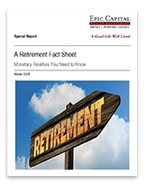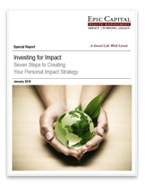Bad Spending Habits That Can Be Corrected
Jun 12, 2019
Americans have a great deal of disposable income relative to many other nations, yet our free spending can take us further and further away from the potential for financial freedom. Some people fall into crippling spending habits and injure their finances as a consequence.
Failing to Save
Saving even $50 or $100 a month – isn’t that hard under most financial conditions. Even so, some households don’t put much of a priority on building a cash reserve of some kind, a portion of which could be used for equity investment.
When you don’t make saving a goal, you don’t have any money to withdraw in a pinch – so if you need to get ahold of some money, where do you find it? Basically, you have three options. One, turn to friends or Mom or Dad. Two, divert money that would go toward a core need (food, rent, the heating bill) toward the sudden crisis. Three, charge your credit card. (There are other options, but they are best not explored.)
Good habit: save just a little, then a lot.You can start a savings campaign by saving “invisibly” – that is, just spending $10 or $15 or $20 less on a regular expense each month. Maybe two or three, even. That’s less than a dollar a day per expense. When your earnings climb further above your financial baseline, you can increase the amount you save/invest.
Buying Things on a Whim
The correlation between impulsive spending and credit card use isn’t too hard to spot. Spending money you don’t have on material items that will soon depreciate doesn’t put you ahead financially.
Good habit: set a budget when you shop.As you arrive at the market, the mall or the local power center, arrive with a limit on what you will spend on that shopping trip and stick to it. Take an hour (or a day) to mull over any big buying decisions – are you buying something you really need? Lastly, use cash whenever you can.
Living on Margin
Living above your means, charging this and that credit card – this is a path toward runaway debt. You may look rich, but you’ll carry a big financial burden that risks being “out of sight, out of mind” in between credit card statements.
Good habit: strive for lasting affluence, not temporary bling.Possessions symbolize wealth to too many Americans. Real wealth is measured in accumulated assets. They aren’t usually visible, but you can count on them in the future, in contrast to ever-depreciating luxury goods.
Buying Unnecessary Services
Cable subscriptions, extended warranties, service contracts for highly reliable items, health club memberships that translate into little more than an alternate place to shower – they all add up, they all siphon some of our dollars away each month. In many cases, we pay for options rather than necessities.
Good habit: evaluate who benefits most from those services.Are they benefiting the provider more than the consumer? Are they entrees to a “main course” – a steady, long-range financial exploitation?
Go against the norm – it might leave you a little wealthier. In April, Gallup found that 62% of Americans liked saving money more than spending it. Just 34% liked spending more than saving. This appreciation of frugality is relatively new. As recently as 2006, 50% of Americans told Gallup that they enjoyed saving more than spending with 45% preferring spending.1
If we love saving money, a key statistic doesn’t reflect it. According to the Commerce Department, the typical U.S. household was saving 4.8% of its disposable personal income in May. The personal savings rate for 2013 was 4.5%, the least in any year since 2007. Compare that to 6.7% across the 1990s, 9.3% across the 1980s and 11.8% during the 1970s.1,2
Perhaps many of us want to save but can’t due to financial pressures. Perhaps the economic rebound is encouraging personal consumption over saving. Whatever the reason, Americans on the whole don’t seem to be saving very much. That’s the status quo; going against it might help you build wealth a little more easily.
Tags: Financial Help, Spending Habits
More Insights
Few terms in personal finance are as important, or used as frequently, as “risk.” Nevertheless, few terms are as imprecisely defined. Generally, when financial advisors or the media talk about investment risk, their focus is on the historical price volatility of the asset or investment under discussion.
As Americans get their grills and beach chairs ready for the July 4th holiday, the stock market and the weather across much of the country have both been on heaters. Stocks and bonds continue to effectively navigate a complex policy landscape shaped by evolving trade dynamics, geopolitical tensions, and fiscal stimulus. The market’s resilience in … Continue reading “Market Update – America Gets Record High Stock Prices for Its Birthday”
Birthdays may seem less important as you grow older. They may not offer the impact of watershed moments such as getting a driver’s license at 16 and voting at 18. But beginning at age 50, there are several key birthdays that can affect your tax situation, health-care eligibility, and retirement benefits.
During times like these when geopolitical headlines can be unsettling for investors, we at LPL Research like to remind ourselves of one of our key investing principles. Markets have always faced challenges —ranging from geopolitical conflicts and economic downturns to natural disasters, political upheaval and health crises. These events often trigger short-term volatility and shake … Continue reading “Why Long Term Investing Beats Selling in Volatile Times”
Are you concerned about the inheritance taxes your heirs may have to pay? Then you may want to consider creating charitable lead trusts.
Services
Epic Capital provides the following comprehensive financial planning and investment management services: Learn More >


 Top of Page
Top of Page











